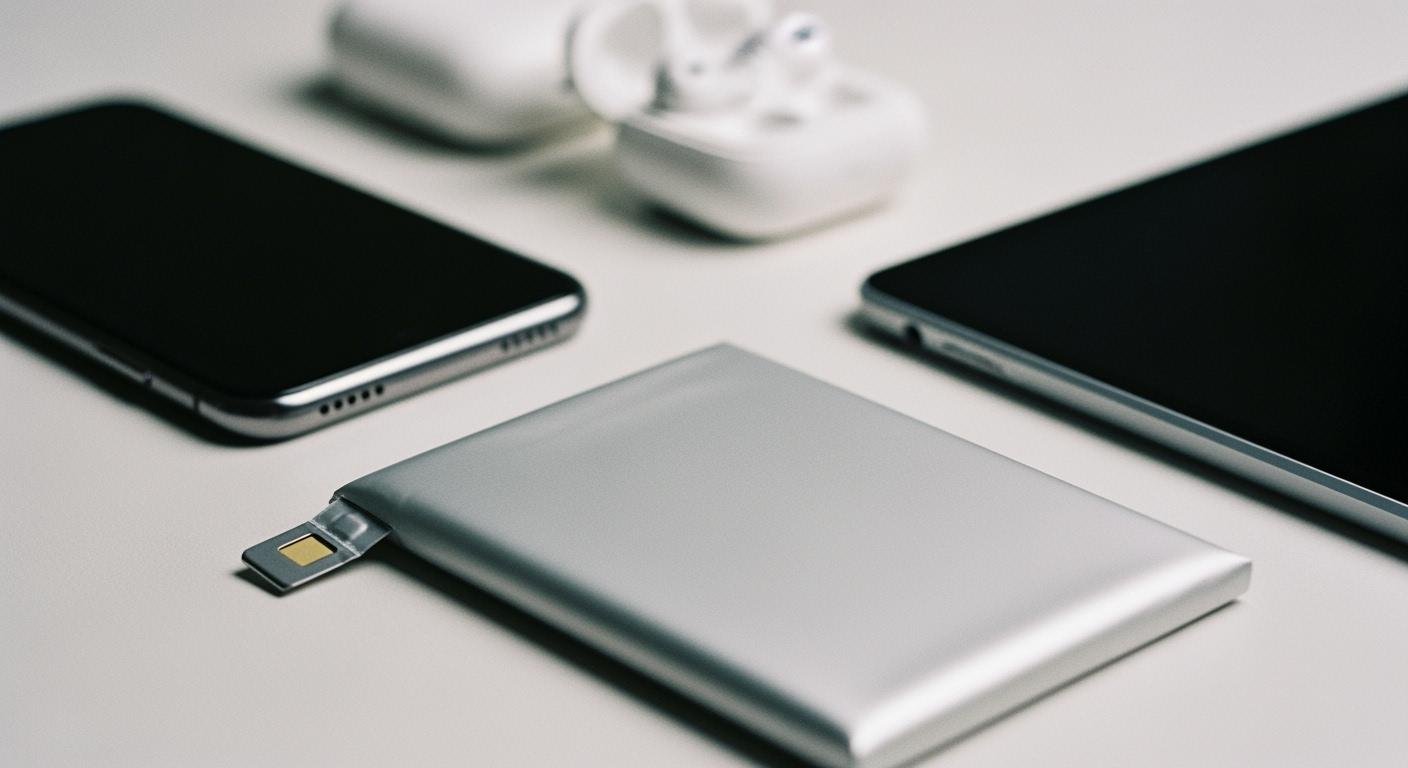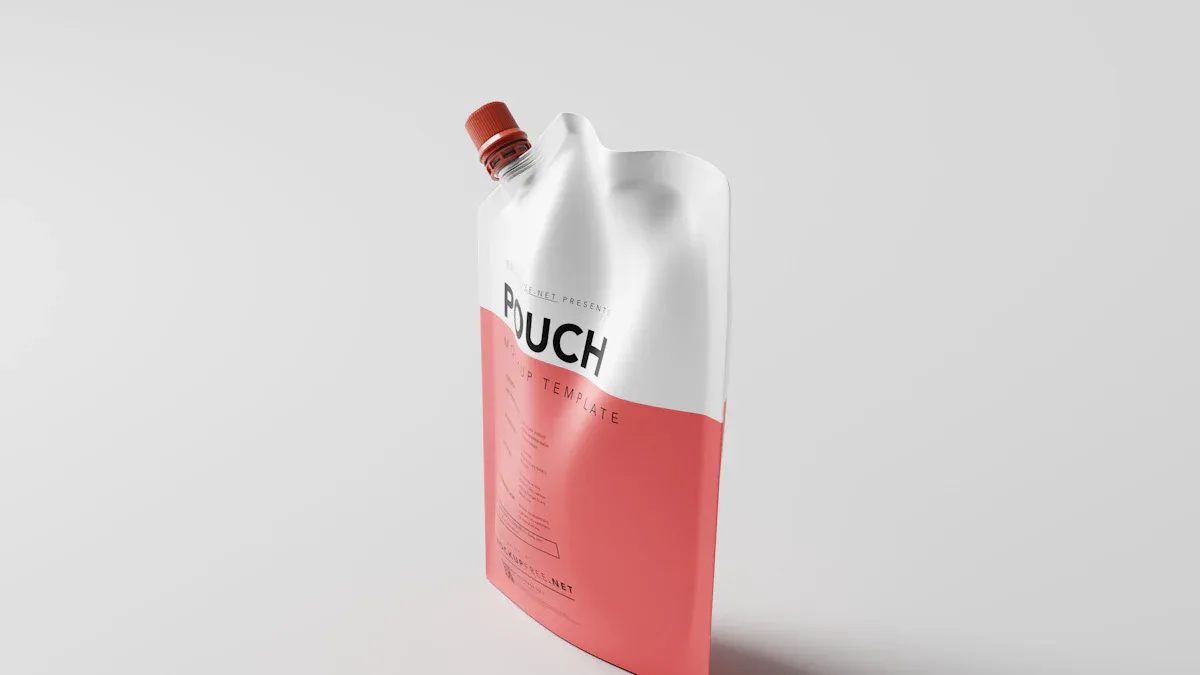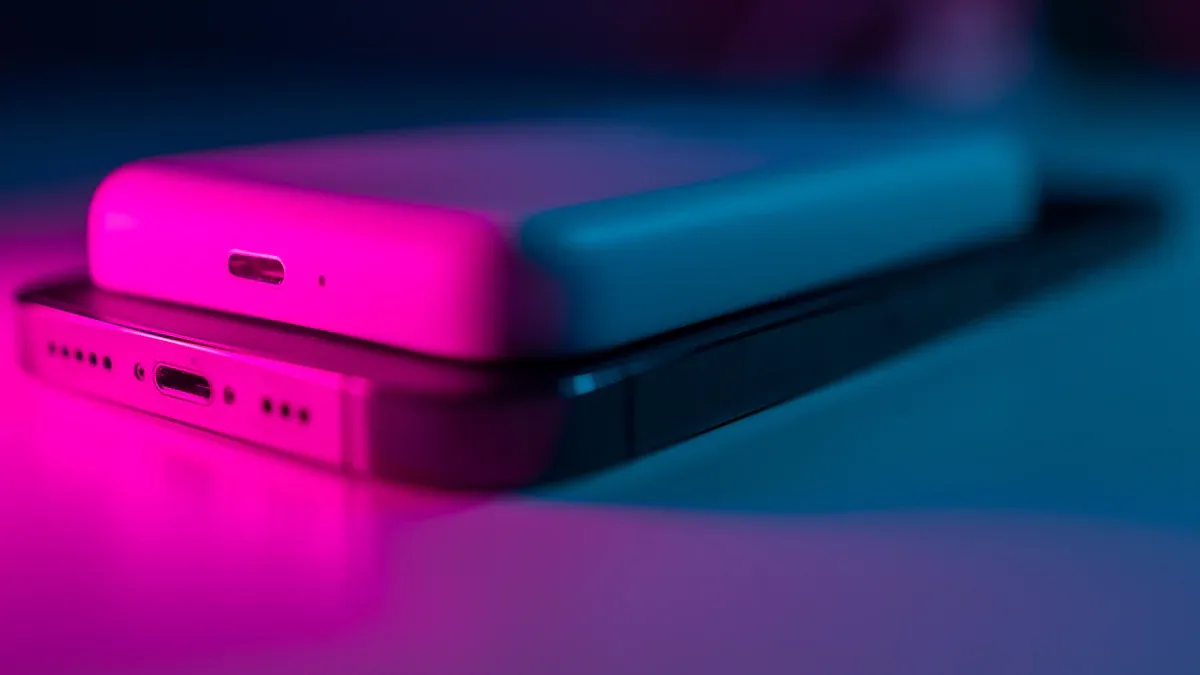
Pouch lithium ion batteries offer unmatched energy density. Their design flexibility powers today’s slim devices. The market for these lithium-ion cells is expanding quickly, with projections showing a compound annual growth rate of around 9% over the next decade. This article analyzes different lithium-ion cell formats. It compares the performance, safety, and power of various battery formats.
Understanding different lithium-ion cell formats is key. Engineers must weigh cell performance, power, density, and safety. This analysis helps compare pouch cells against other formats. The goal is to evaluate high energy density, power, performance, and safety across all cell formats for optimal selection. These cells offer great density and safety.
What Are Pouch Lithium Ion Batteries?

Pouch lithium ion batteries are a type of lithium-ion battery defined by their unique, flexible packaging. Unlike cylindrical or prismatic formats that use rigid metal cases, pouch cells enclose their components in a soft, heat-sealed laminate pouch. This design directly impacts their performance, safety, and application suitability. The flexible nature of these lithium-ion cells allows for very high packaging efficiency, making them a top choice for space-constrained devices.
Laminated Architecture and Construction
The construction of pouch cells involves stacking the core lithium-ion components—cathode, anode, and separator—in layers. Manufacturers then seal these layers inside a multi-layer pouch. This pouch is typically made from a combination of materials, each serving a specific purpose.
- Aluminum Foil: Acts as a moisture barrier.
- Polyamide: Provides puncture resistance.
- Polypropylene: Serves as the inner sealant layer.
This laminated structure protects the internal battery cell from the environment while remaining lightweight. The final battery has foil tabs that extend from the seals to act as positive and negative terminals for the power connection. This construction improves the electrochemical performance and capacity of the cells.
Core Advantages and Trade-Offs
The primary advantage of pouch cells is their superior energy density and design flexibility. The absence of a heavy metal casing means a higher proportion of the battery’s weight is active material, boosting capacity and cell performance. This lightweight construction is critical for applications where every gram matters. The flat format of the cells also helps with heat dissipation, which is important for maintaining good electrochemical performance during rapid cycling.
Note on Safety and Durability: The flexible casing of pouch cells is also their main weakness. These lithium-ion cells are vulnerable to punctures and swelling if overcharged or exposed to high temperatures. Without a rigid structure, they require external support within a device to protect against physical stress and manage swelling over their cycling lifespan. This trade-off means that while the battery cell itself is light, the overall system may need added structural components to ensure safety and durability, which can impact the final power density. This is a key consideration for any lithium battery design.
Pouch Cells vs. Other Lithium-Ion Formats
Engineers choose a lithium-ion battery based on specific project needs. The three main lithium-ion cell formats are pouch, cylindrical, and prismatic. Each format offers a unique balance of performance, safety, and cost. Understanding these differences is crucial for selecting the right battery for an application. This section compares these lithium-ion cell formats across several key metrics.
Energy Density and Weight
Pouch cells excel in gravimetric energy density. They lack a heavy metal case, which gives them a significant weight advantage. This design means a higher percentage of the battery is active material that stores energy. Cylindrical and prismatic formats use rigid metal casings that add weight and reduce the overall energy-to-weight ratio. The higher energy density makes pouch cells ideal for portable electronics where light weight is essential.
While pouch cells lead in weight, prismatic lithium-ion cells are catching up in volumetric density. Innovations in prismatic cell formats are improving their space efficiency. However, pouch lithium ion batteries currently offer the best combination of high capacity and minimal weight among all cell formats.
| Тип ячейки | Gravimetric Energy Density (Wh/kg) |
|---|---|
| Чехол | 200 – 260 |
| Цилиндрические | 150 - 200 |
| Призматический | 120 – 180 |
Design and Form Factor Flexibility
Design flexibility is the standout feature of pouch cells. Their soft, pliable packaging allows manufacturers to create batteries in custom shapes and sizes. This adaptability is impossible to achieve with rigid cylindrical or prismatic formats. This flexibility enables the creation of innovative devices.
- Curved batteries for smartwatches and fitness trackers.
- Ultra-thin batteries for foldable smartphones.
- Flexible batteries for wearable technology and medical implants.
This ability to conform to a product’s design, rather than designing the product around a standard battery, gives engineers immense freedom. Cylindrical cells, like the common 18650 or 21700 sizes, and prismatic cells have fixed dimensions, which restricts product design.
Durability and Safety
The different lithium-ion cell formats have distinct safety profiles. Cylindrical and prismatic cells have rigid metal cases. These cases provide excellent protection against punctures and physical impacts. Pouch cells, with their soft foil enclosures, are more vulnerable to damage. A puncture can lead to a short circuit and thermal runaway.
Note on Swelling: Pouch cells can swell when gas builds up inside. This gas generation can result from overcharging, high temperatures, manufacturing defects, or internal short circuits. A failing Battery Management System (BMS) can also cause conditions that lead to swelling.
Cylindrical lithium-ion cells often include built-in safety features that are activated by pressure. These include Current Interrupt Devices (CIDs) and vents that release gas to prevent a rupture. Pouch cells cannot use these pressure-based mechanisms. Instead, their safety relies on shutdown separators that melt at high temperatures to stop ion flow and external protection circuits. The overall safety of a lithium battery system depends on both the battery cell design and the device’s protective housing. Ensuring the safety of all lithium-ion cells is a top priority.
Терморегулирование
Effective thermal management is critical for the performance and safety of any lithium battery. Cylindrical cells can be spaced apart in a battery pack, allowing air or liquid to flow between them for cooling. Prismatic cells have large, flat surfaces that provide good contact for cooling plates.
Pouch cells present a unique challenge. When stacked tightly in a module, heat can become trapped in the center. Their large surface area helps dissipate heat, but dense packing can counteract this benefit. Advanced cooling strategies are often necessary for high-power applications. These methods include:
- Phase Change Materials (PCMs) that absorb heat.
- Liquid cooling plates placed between cells.
- Hybrid systems that combine active and passive cooling.
Proper thermal management ensures optimal cell performance and extends the battery’s life.
Cycle Life and Longevity
The longevity of a lithium-ion battery is measured in cycling capability. All lithium-ion cell formats degrade over time with repeated charging and discharging. For pouch cells, mechanical stress plays a significant role in their aging process. The cells naturally swell and contract during cycling.
Applying a small amount of external pressure can improve the cycle life of pouch cells. This compression helps maintain good contact between the internal layers, which can reduce capacity fade. However, too much pressure can damage the separator and accelerate degradation. Flexible compression systems that adapt to the battery’s state often provide the best results for extending the cycling life and power output. The relationship between pressure, swelling, and aging is a key factor in designing long-lasting power systems with pouch cells.
Manufacturing Cost
Manufacturing cost varies significantly across the three lithium-ion cell formats. Cylindrical cells are the most economical to produce. Their manufacturing processes are highly automated and have been refined over decades, leading to low costs per unit of capacity.
Prismatic cells are generally more expensive due to more complex assembly and lower production volumes. Pouch cells have a relatively simple assembly process, but the materials for the pouch and the need for careful handling can add to the cost. The final cost of a lithium battery pack also includes the BMS and structural housing, which can be more complex for pouch cells to ensure safety and durability. The choice between cell formats often involves a trade-off between the battery cell cost and the total system cost.
Ideal Applications for Pouch Batteries

The unique characteristics of pouch cells make them the ideal power source for specific applications. Their high energy density and design flexibility solve critical engineering challenges across several industries. Different lithium-ion cell formats serve different needs, but pouch formats excel where space and weight are top priorities.
Бытовая электроника
Modern consumer electronics demand thin, lightweight designs. Pouch cells are essential for devices like smartphones, tablets, and ultra-thin laptops. Their flexible form factor allows engineers to maximize the internal space of a device. This results in a higher capacity battery without increasing the product’s size or weight. The excellent cycling performance of these lithium-ion cells ensures a long product life.
Электромобили
Major automakers like GM, Hyundai, and Ford use pouch cells in their electric vehicles. These lithium-ion cells deliver high power surges for acceleration and manage heat efficiently. Their modularity allows for customizable battery pack designs. GM, for example, prefers using the largest possible pouch cells to simplify pack construction.
However, using pouch cells in EVs presents safety challenges. Unlike other formats with built-in vents, pouch cells can burst during thermal runaway. This requires advanced safety systems. Engineers use compression pads to manage swelling during cycling and specialized flame barriers to prevent fire from spreading between cells.
Дроны и RC-устройства
Drones and remote-controlled devices need lightweight power for maximum flight time and agility. Pouch cells, especially Lithium-Polymer (LiPo) types, are the standard for this application. They offer a high discharge rate, providing the bursts of power needed for sharp maneuvers in racing drones. A lighter battery directly translates to longer flight times. The high power density of these lithium-ion cells is unmatched by other lithium-ion cell formats for high-performance flight. The cycling capacity of the lithium battery is also a key factor.
Medical and Wearable Tech
The medical field benefits greatly from custom-shaped pouch lithium ion batteries. These cells power life-sustaining devices like heart pumps and portable oxygen concentrators, giving patients more freedom. Wearable technology also relies on these compact power sources.
- Smartwatches
- Health patches
- Insulin pumps
- Biosensors
The ability to create a battery that fits the device, rather than designing the device around a standard battery, is a significant advantage. This improves patient comfort and device performance. The capacity and cycling of these cells are critical for reliable operation.
Key Selection Criteria
Choosing the right lithium-ion battery requires careful thought. Engineers must evaluate application needs, battery chemistry, and management systems. These factors determine the final product’s performance, safety, and cost. Different lithium-ion formats serve different purposes.
Evaluating Application Needs
The first step is to define the product’s primary requirements. Does the device need to be as light as possible? Is long-term durability more important? Pouch cells offer great design freedom. However, other lithium-ion formats like cylindrical cells may offer better durability. For home energy storage, safety and a long cycling life are critical. In this case, other formats might be a better choice. The selection of a lithium battery format depends entirely on the application’s main goals. The best battery cell is the one that fits the project’s needs.
Impact of Lithium Battery Chemistry
The chemistry inside lithium-ion cells defines their behavior. Different materials provide different levels of energy, power, and safety. The three common chemistries for lithium-ion cells are LCO, NMC, and LFP. Each offers a unique trade-off between capacity and stability.
| Химия | Плотность энергии | Продолжительность жизни | Термическая стабильность |
|---|---|---|---|
| LCO | Высокий | Short | Низкий |
| NMC | Высокий | Средний | Средний |
| LFP | Нижний | Длинный | Высокий |
LFP chemistry provides excellent safety and a long life, making it ideal for applications that prioritize durability. The choice of chemistry directly impacts the overall cell performance and electrochemical performance of the lithium-ion cells.
Role of the Battery Management System
A Battery Management System (BMS) is the brain of a lithium battery. It is essential for the safety and performance of all lithium-ion cells, especially pouch cells. The BMS protects the battery from damage. It ensures the cells operate within safe limits.
A smart BMS performs several key jobs:
- Monitoring: It watches the voltage and temperature of all cells.
- Защита: It prevents overcharging and over-discharging.
- Balancing: It keeps the capacity of all cells equal to maximize power.
- Reporting: It communicates the battery’s state of charge and health.
Advanced safety designs for pouch cells also include special separators. These can warn of internal problems and improve resistance to thermal runaway. A good BMS is vital for the safety and capacity of any lithium-ion battery system.
Pouch cells provide top energy density and design flexibility. This performance requires strong mechanical protection for the cells. Good thermal management is also vital for the safety of these lithium-ion cells. No single battery format is universally best. The choice between different lithium-ion formats depends on the application’s main goals for the cells.
Engineers must balance performance, density, and safety. Pouch cells are the leading option among all cell formats when space and weight are the most critical factors for the cells. The safety of the cells is always a priority across all formats.
ЧАСТО ЗАДАВАЕМЫЕ ВОПРОСЫ
Why do pouch cells swell?
Gas builds up inside the pouch cells during operation. Overcharging, high heat, or internal damage can cause this buildup. The flexible design of these cells allows them to expand, which results in visible swelling. Proper handling of the cells is important.
Are pouch cells better than cylindrical cells?
The best battery depends on the product’s needs. Pouch cells offer superior design freedom and light weight. Cylindrical cells provide better durability and lower cost. The choice between these cells is always application-specific. Engineers select the best cells for the job.
Can you repair a swollen pouch battery?
No. A swollen battery is a serious safety hazard. Users should never try to fix or puncture swollen cells. Safely dispose of damaged cells immediately according to local regulations. Replacing the cells is the only safe option.
What makes pouch cells good for drones?
Drones require lightweight power for flight. Pouch cells are very light, which extends flight time. The high power output from these cells allows for quick maneuvers. This performance makes these cells ideal for high-agility applications.

